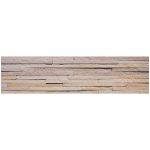Introduction
When it comes to transforming your outdoor living space, stone veneer landscaping offers a versatile and aesthetically pleasing solution. Stone veneer, a lightweight and cost-effective alternative to natural stone, can be used in a variety of landscaping projects to create stunning visual effects. From accent walls to fire pits, walkways to water features, stone veneer can add texture, depth, and character to any outdoor environment. In this comprehensive guide, we will explore the benefits, design options, installation process, and maintenance tips for incorporating stone veneer into your landscaping projects.
Benefits of Stone Veneer Landscaping
1. Versatility: One of the key advantages of stone veneer is its versatility. It can be used in a wide range of landscaping applications, including retaining walls, columns, façades, and more. With a variety of colors, shapes, and textures available, stone veneer can be customized to suit any style or design preference.
2. Cost-Effectiveness: Compared to natural stone, stone veneer is a more affordable option for landscaping projects. It offers the same visual appeal as natural stone but at a fraction of the cost. Additionally, the lightweight nature of stone veneer makes it easier to transport and install, reducing labor costs.
3. Durability: Stone veneer is durable and long-lasting, able to withstand the elements and maintain its appearance over time. It is resistant to fading, cracking, and chipping, making it an ideal choice for outdoor applications. With proper care and maintenance, stone veneer can retain its beauty for years to come.
4. Easy Installation: Installing stone veneer is a straightforward process that can be completed by DIY enthusiasts or professional landscapers. The lightweight nature of stone veneer makes it easy to handle and maneuver, reducing the time and effort required for installation. With the right tools and techniques, you can achieve professional-looking results with stone veneer.
Design Options for Stone Veneer Landscaping
1. Accent Walls: Stone veneer accent walls can add visual interest and texture to your outdoor space. Whether used as a backdrop for a seating area or to define a garden bed, an accent wall made of stone veneer can create a focal point in your landscape design.
2. Fire Features: Stone veneer is an excellent choice for creating fire pits, fireplaces, and other fire features in your outdoor space. The natural look and feel of stone veneer complement the warmth and ambiance of a fire, making it a popular choice for outdoor entertaining.

3. click this and Patios: Stone veneer can be used to create beautiful walkways, patios, and outdoor living areas. Whether you prefer a rustic cobblestone look or a sleek modern design, stone veneer can be tailored to suit your style preferences.
4. Water Features: Stone veneer can also be used to enhance water features such as fountains, ponds, and waterfalls. The natural texture and color variations of stone veneer can create a serene and inviting atmosphere in your outdoor space.
Installation Process for Stone Veneer Landscaping
1. Preparation: Before installing stone veneer, it is important to prepare the surface properly. Ensure that the substrate is clean, dry, and free of debris. If necessary, apply a weather-resistant barrier to protect against moisture and ensure proper adhesion.
2. Layout: Plan the layout of the stone veneer by dry-fitting the pieces and arranging them in the desired pattern. This will help you visualize the final design and make any adjustments before securing the stones in place.
3. Adhesive Application: Apply a high-quality construction adhesive to the back of each stone veneer piece. Press the stone firmly against the substrate, ensuring good contact and adhesion. Use spacers to maintain consistent spacing between stones.
4. Grouting: Once the stone veneer pieces are in place, fill in the gaps between them with grout or mortar. This will help secure the stones and create a seamless appearance. Use a grout bag or trowel to apply the grout evenly.
5. Sealing: To protect the stone veneer and enhance its durability, consider applying a sealant after the installation is complete. A high-quality sealant will help prevent staining, moisture penetration, and UV damage, ensuring the longevity of your stone veneer landscaping.
Maintenance Tips for Stone Veneer Landscaping
1. Regular Cleaning: To keep your stone veneer looking its best, regularly clean it with a mild detergent and water. Avoid using harsh chemicals or abrasive cleaners, as they can damage the surface of the stone veneer.
2. Sealing: Periodically reseal the stone veneer to maintain its protective barrier against stains and moisture. Depending on the type of sealant used, you may need to reapply it every 1-3 years to ensure optimal protection.
3. Inspect for Damage: Routinely inspect your stone veneer landscaping for any signs of damage, such as cracks, chips, or loose stones. Address any issues promptly to prevent further deterioration and maintain the integrity of the installation.
4. Preventative Measures: To minimize wear and tear on your stone veneer, avoid placing heavy objects on it, such as furniture or equipment. Use caution when using power tools or equipment near the stone veneer to prevent accidental damage.
Conclusion
Stone veneer landscaping offers a versatile and visually appealing way to enhance your outdoor space. With its versatility, cost-effectiveness, durability, and easy installation, stone veneer is a popular choice for a wide range of landscaping projects. Whether you are looking to create accent walls, fire features, walkways, or water features, stone veneer can help you achieve the look and feel you desire. By following the design options, installation process, and maintenance tips outlined in this guide, you can create a stunning outdoor environment that will be enjoyed for years to come.
